Occupational Health and Safety: Smoking Cessation Program
VerifiedAdded on 2023/06/15
|12
|3089
|99
AI Summary
This report outlines an occupational health management plan for smoking cessation in the workplace. It describes the workplace, occupational health hazard, associated risks, ethical and legal requirements, and the health program that addresses the concern. The desired outcomes and goals of the program are outlined, along with the process of monitoring and evaluation.
Contribute Materials
Your contribution can guide someone’s learning journey. Share your
documents today.
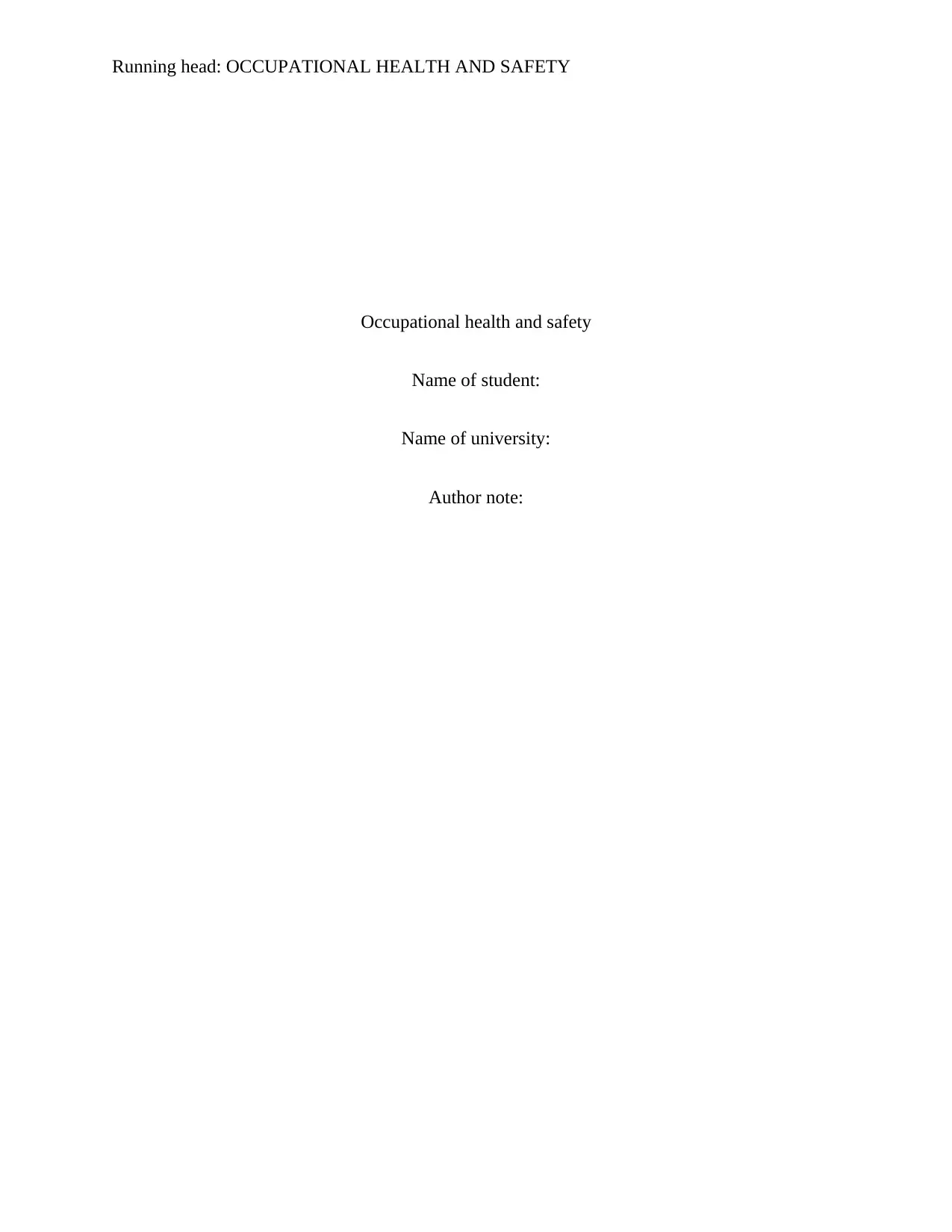
Running head: OCCUPATIONAL HEALTH AND SAFETY
Occupational health and safety
Name of student:
Name of university:
Author note:
Occupational health and safety
Name of student:
Name of university:
Author note:
Secure Best Marks with AI Grader
Need help grading? Try our AI Grader for instant feedback on your assignments.
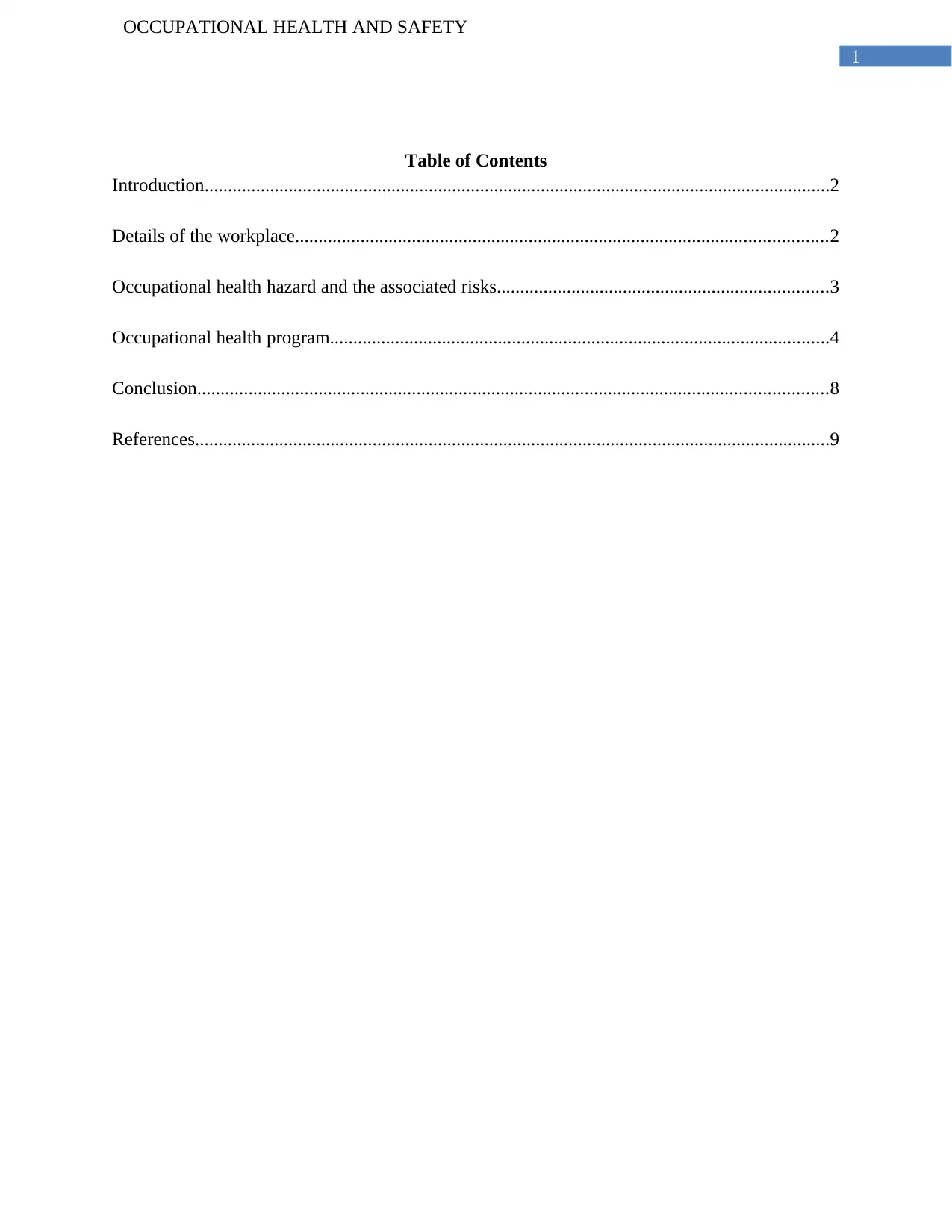
1
OCCUPATIONAL HEALTH AND SAFETY
Table of Contents
Introduction......................................................................................................................................2
Details of the workplace..................................................................................................................2
Occupational health hazard and the associated risks.......................................................................3
Occupational health program...........................................................................................................4
Conclusion.......................................................................................................................................8
References........................................................................................................................................9
OCCUPATIONAL HEALTH AND SAFETY
Table of Contents
Introduction......................................................................................................................................2
Details of the workplace..................................................................................................................2
Occupational health hazard and the associated risks.......................................................................3
Occupational health program...........................................................................................................4
Conclusion.......................................................................................................................................8
References........................................................................................................................................9
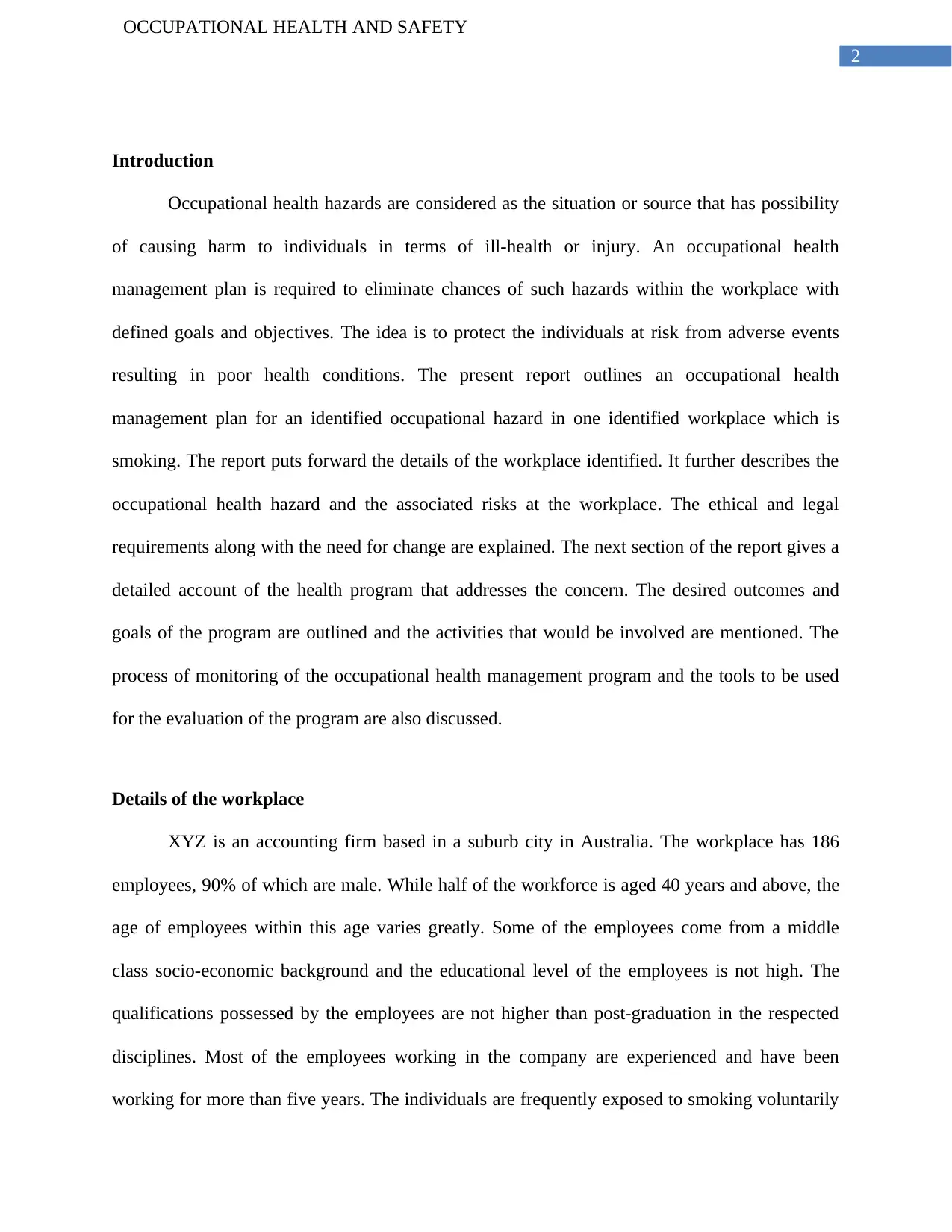
2
OCCUPATIONAL HEALTH AND SAFETY
Introduction
Occupational health hazards are considered as the situation or source that has possibility
of causing harm to individuals in terms of ill-health or injury. An occupational health
management plan is required to eliminate chances of such hazards within the workplace with
defined goals and objectives. The idea is to protect the individuals at risk from adverse events
resulting in poor health conditions. The present report outlines an occupational health
management plan for an identified occupational hazard in one identified workplace which is
smoking. The report puts forward the details of the workplace identified. It further describes the
occupational health hazard and the associated risks at the workplace. The ethical and legal
requirements along with the need for change are explained. The next section of the report gives a
detailed account of the health program that addresses the concern. The desired outcomes and
goals of the program are outlined and the activities that would be involved are mentioned. The
process of monitoring of the occupational health management program and the tools to be used
for the evaluation of the program are also discussed.
Details of the workplace
XYZ is an accounting firm based in a suburb city in Australia. The workplace has 186
employees, 90% of which are male. While half of the workforce is aged 40 years and above, the
age of employees within this age varies greatly. Some of the employees come from a middle
class socio-economic background and the educational level of the employees is not high. The
qualifications possessed by the employees are not higher than post-graduation in the respected
disciplines. Most of the employees working in the company are experienced and have been
working for more than five years. The individuals are frequently exposed to smoking voluntarily
OCCUPATIONAL HEALTH AND SAFETY
Introduction
Occupational health hazards are considered as the situation or source that has possibility
of causing harm to individuals in terms of ill-health or injury. An occupational health
management plan is required to eliminate chances of such hazards within the workplace with
defined goals and objectives. The idea is to protect the individuals at risk from adverse events
resulting in poor health conditions. The present report outlines an occupational health
management plan for an identified occupational hazard in one identified workplace which is
smoking. The report puts forward the details of the workplace identified. It further describes the
occupational health hazard and the associated risks at the workplace. The ethical and legal
requirements along with the need for change are explained. The next section of the report gives a
detailed account of the health program that addresses the concern. The desired outcomes and
goals of the program are outlined and the activities that would be involved are mentioned. The
process of monitoring of the occupational health management program and the tools to be used
for the evaluation of the program are also discussed.
Details of the workplace
XYZ is an accounting firm based in a suburb city in Australia. The workplace has 186
employees, 90% of which are male. While half of the workforce is aged 40 years and above, the
age of employees within this age varies greatly. Some of the employees come from a middle
class socio-economic background and the educational level of the employees is not high. The
qualifications possessed by the employees are not higher than post-graduation in the respected
disciplines. Most of the employees working in the company are experienced and have been
working for more than five years. The individuals are frequently exposed to smoking voluntarily
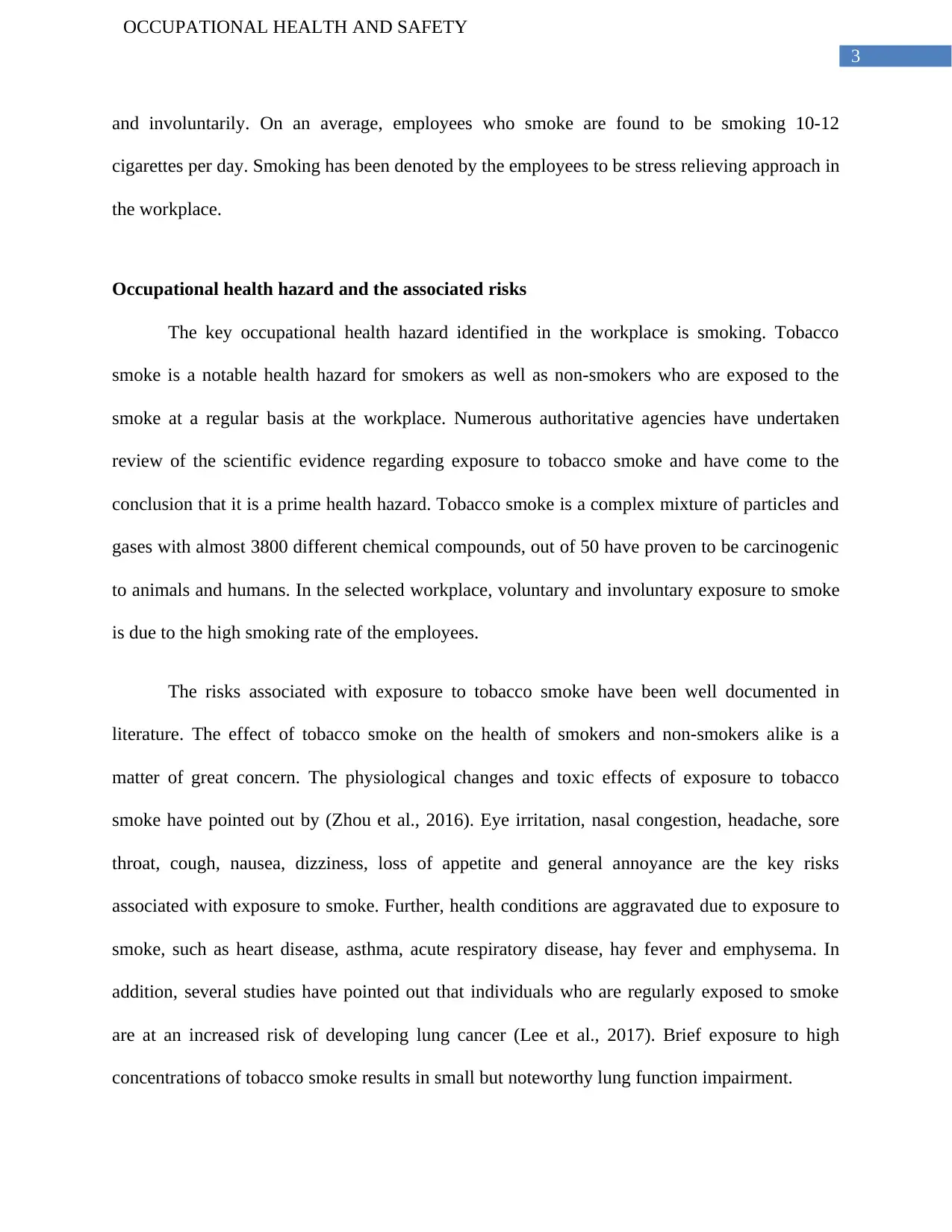
3
OCCUPATIONAL HEALTH AND SAFETY
and involuntarily. On an average, employees who smoke are found to be smoking 10-12
cigarettes per day. Smoking has been denoted by the employees to be stress relieving approach in
the workplace.
Occupational health hazard and the associated risks
The key occupational health hazard identified in the workplace is smoking. Tobacco
smoke is a notable health hazard for smokers as well as non-smokers who are exposed to the
smoke at a regular basis at the workplace. Numerous authoritative agencies have undertaken
review of the scientific evidence regarding exposure to tobacco smoke and have come to the
conclusion that it is a prime health hazard. Tobacco smoke is a complex mixture of particles and
gases with almost 3800 different chemical compounds, out of 50 have proven to be carcinogenic
to animals and humans. In the selected workplace, voluntary and involuntary exposure to smoke
is due to the high smoking rate of the employees.
The risks associated with exposure to tobacco smoke have been well documented in
literature. The effect of tobacco smoke on the health of smokers and non-smokers alike is a
matter of great concern. The physiological changes and toxic effects of exposure to tobacco
smoke have pointed out by (Zhou et al., 2016). Eye irritation, nasal congestion, headache, sore
throat, cough, nausea, dizziness, loss of appetite and general annoyance are the key risks
associated with exposure to smoke. Further, health conditions are aggravated due to exposure to
smoke, such as heart disease, asthma, acute respiratory disease, hay fever and emphysema. In
addition, several studies have pointed out that individuals who are regularly exposed to smoke
are at an increased risk of developing lung cancer (Lee et al., 2017). Brief exposure to high
concentrations of tobacco smoke results in small but noteworthy lung function impairment.
OCCUPATIONAL HEALTH AND SAFETY
and involuntarily. On an average, employees who smoke are found to be smoking 10-12
cigarettes per day. Smoking has been denoted by the employees to be stress relieving approach in
the workplace.
Occupational health hazard and the associated risks
The key occupational health hazard identified in the workplace is smoking. Tobacco
smoke is a notable health hazard for smokers as well as non-smokers who are exposed to the
smoke at a regular basis at the workplace. Numerous authoritative agencies have undertaken
review of the scientific evidence regarding exposure to tobacco smoke and have come to the
conclusion that it is a prime health hazard. Tobacco smoke is a complex mixture of particles and
gases with almost 3800 different chemical compounds, out of 50 have proven to be carcinogenic
to animals and humans. In the selected workplace, voluntary and involuntary exposure to smoke
is due to the high smoking rate of the employees.
The risks associated with exposure to tobacco smoke have been well documented in
literature. The effect of tobacco smoke on the health of smokers and non-smokers alike is a
matter of great concern. The physiological changes and toxic effects of exposure to tobacco
smoke have pointed out by (Zhou et al., 2016). Eye irritation, nasal congestion, headache, sore
throat, cough, nausea, dizziness, loss of appetite and general annoyance are the key risks
associated with exposure to smoke. Further, health conditions are aggravated due to exposure to
smoke, such as heart disease, asthma, acute respiratory disease, hay fever and emphysema. In
addition, several studies have pointed out that individuals who are regularly exposed to smoke
are at an increased risk of developing lung cancer (Lee et al., 2017). Brief exposure to high
concentrations of tobacco smoke results in small but noteworthy lung function impairment.
Secure Best Marks with AI Grader
Need help grading? Try our AI Grader for instant feedback on your assignments.
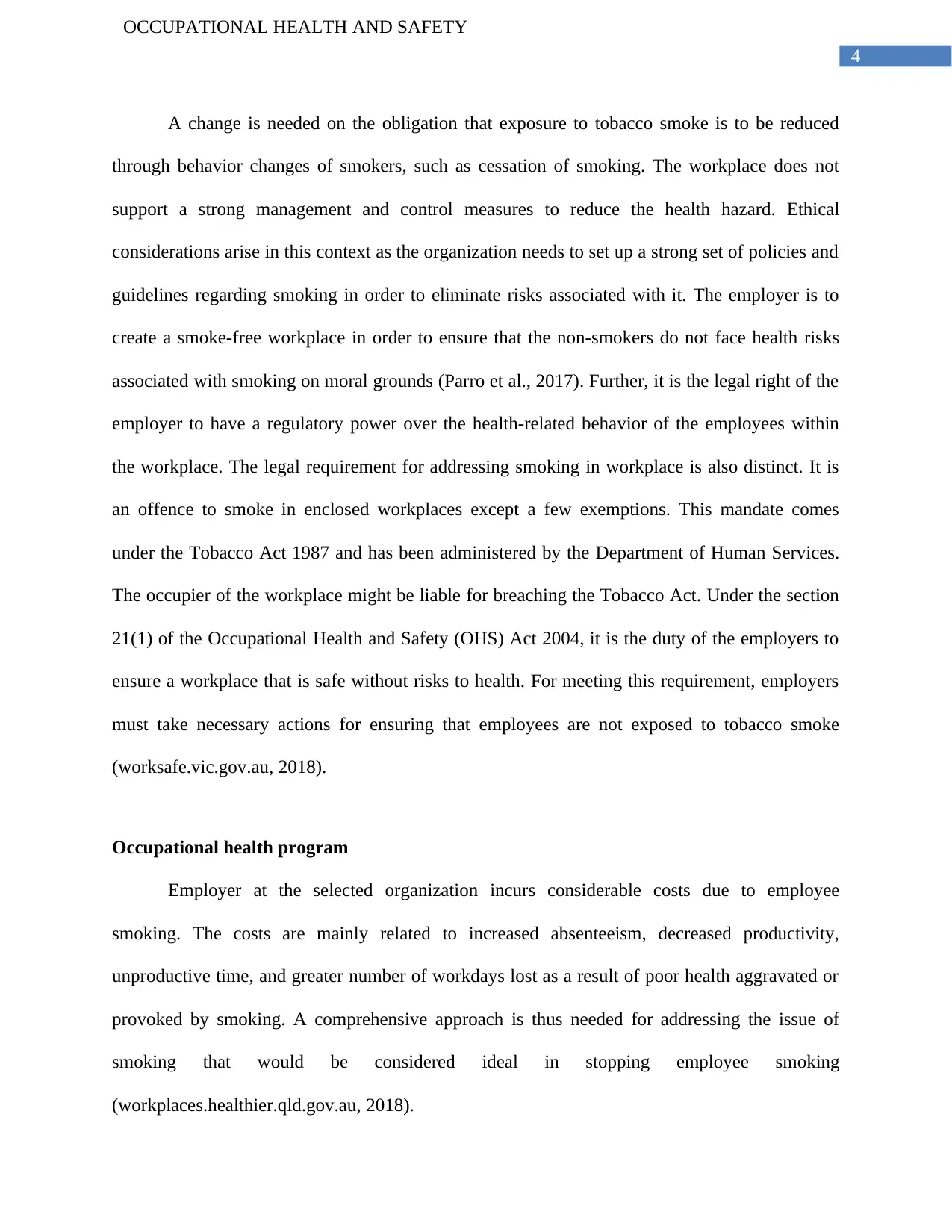
4
OCCUPATIONAL HEALTH AND SAFETY
A change is needed on the obligation that exposure to tobacco smoke is to be reduced
through behavior changes of smokers, such as cessation of smoking. The workplace does not
support a strong management and control measures to reduce the health hazard. Ethical
considerations arise in this context as the organization needs to set up a strong set of policies and
guidelines regarding smoking in order to eliminate risks associated with it. The employer is to
create a smoke-free workplace in order to ensure that the non-smokers do not face health risks
associated with smoking on moral grounds (Parro et al., 2017). Further, it is the legal right of the
employer to have a regulatory power over the health-related behavior of the employees within
the workplace. The legal requirement for addressing smoking in workplace is also distinct. It is
an offence to smoke in enclosed workplaces except a few exemptions. This mandate comes
under the Tobacco Act 1987 and has been administered by the Department of Human Services.
The occupier of the workplace might be liable for breaching the Tobacco Act. Under the section
21(1) of the Occupational Health and Safety (OHS) Act 2004, it is the duty of the employers to
ensure a workplace that is safe without risks to health. For meeting this requirement, employers
must take necessary actions for ensuring that employees are not exposed to tobacco smoke
(worksafe.vic.gov.au, 2018).
Occupational health program
Employer at the selected organization incurs considerable costs due to employee
smoking. The costs are mainly related to increased absenteeism, decreased productivity,
unproductive time, and greater number of workdays lost as a result of poor health aggravated or
provoked by smoking. A comprehensive approach is thus needed for addressing the issue of
smoking that would be considered ideal in stopping employee smoking
(workplaces.healthier.qld.gov.au, 2018).
OCCUPATIONAL HEALTH AND SAFETY
A change is needed on the obligation that exposure to tobacco smoke is to be reduced
through behavior changes of smokers, such as cessation of smoking. The workplace does not
support a strong management and control measures to reduce the health hazard. Ethical
considerations arise in this context as the organization needs to set up a strong set of policies and
guidelines regarding smoking in order to eliminate risks associated with it. The employer is to
create a smoke-free workplace in order to ensure that the non-smokers do not face health risks
associated with smoking on moral grounds (Parro et al., 2017). Further, it is the legal right of the
employer to have a regulatory power over the health-related behavior of the employees within
the workplace. The legal requirement for addressing smoking in workplace is also distinct. It is
an offence to smoke in enclosed workplaces except a few exemptions. This mandate comes
under the Tobacco Act 1987 and has been administered by the Department of Human Services.
The occupier of the workplace might be liable for breaching the Tobacco Act. Under the section
21(1) of the Occupational Health and Safety (OHS) Act 2004, it is the duty of the employers to
ensure a workplace that is safe without risks to health. For meeting this requirement, employers
must take necessary actions for ensuring that employees are not exposed to tobacco smoke
(worksafe.vic.gov.au, 2018).
Occupational health program
Employer at the selected organization incurs considerable costs due to employee
smoking. The costs are mainly related to increased absenteeism, decreased productivity,
unproductive time, and greater number of workdays lost as a result of poor health aggravated or
provoked by smoking. A comprehensive approach is thus needed for addressing the issue of
smoking that would be considered ideal in stopping employee smoking
(workplaces.healthier.qld.gov.au, 2018).
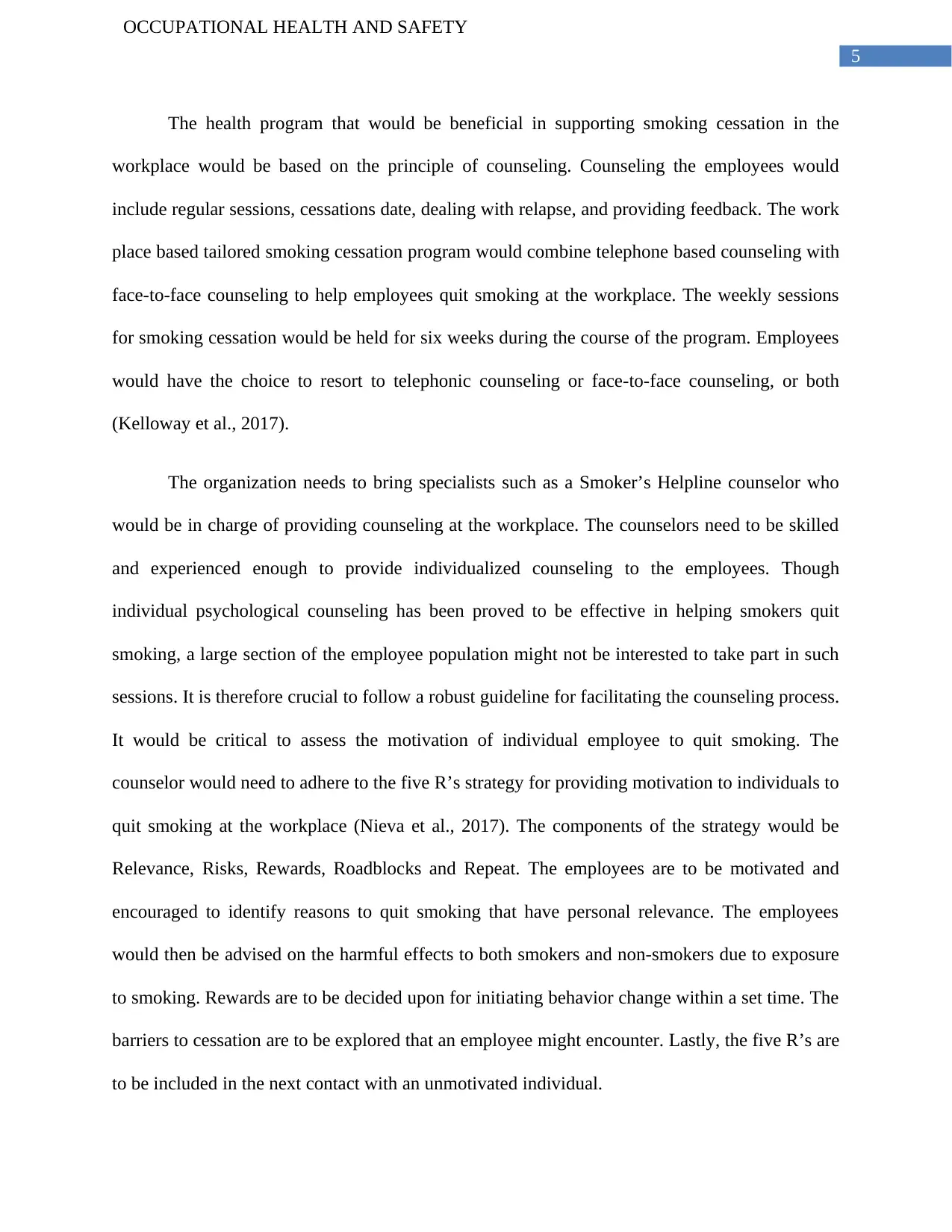
5
OCCUPATIONAL HEALTH AND SAFETY
The health program that would be beneficial in supporting smoking cessation in the
workplace would be based on the principle of counseling. Counseling the employees would
include regular sessions, cessations date, dealing with relapse, and providing feedback. The work
place based tailored smoking cessation program would combine telephone based counseling with
face-to-face counseling to help employees quit smoking at the workplace. The weekly sessions
for smoking cessation would be held for six weeks during the course of the program. Employees
would have the choice to resort to telephonic counseling or face-to-face counseling, or both
(Kelloway et al., 2017).
The organization needs to bring specialists such as a Smoker’s Helpline counselor who
would be in charge of providing counseling at the workplace. The counselors need to be skilled
and experienced enough to provide individualized counseling to the employees. Though
individual psychological counseling has been proved to be effective in helping smokers quit
smoking, a large section of the employee population might not be interested to take part in such
sessions. It is therefore crucial to follow a robust guideline for facilitating the counseling process.
It would be critical to assess the motivation of individual employee to quit smoking. The
counselor would need to adhere to the five R’s strategy for providing motivation to individuals to
quit smoking at the workplace (Nieva et al., 2017). The components of the strategy would be
Relevance, Risks, Rewards, Roadblocks and Repeat. The employees are to be motivated and
encouraged to identify reasons to quit smoking that have personal relevance. The employees
would then be advised on the harmful effects to both smokers and non-smokers due to exposure
to smoking. Rewards are to be decided upon for initiating behavior change within a set time. The
barriers to cessation are to be explored that an employee might encounter. Lastly, the five R’s are
to be included in the next contact with an unmotivated individual.
OCCUPATIONAL HEALTH AND SAFETY
The health program that would be beneficial in supporting smoking cessation in the
workplace would be based on the principle of counseling. Counseling the employees would
include regular sessions, cessations date, dealing with relapse, and providing feedback. The work
place based tailored smoking cessation program would combine telephone based counseling with
face-to-face counseling to help employees quit smoking at the workplace. The weekly sessions
for smoking cessation would be held for six weeks during the course of the program. Employees
would have the choice to resort to telephonic counseling or face-to-face counseling, or both
(Kelloway et al., 2017).
The organization needs to bring specialists such as a Smoker’s Helpline counselor who
would be in charge of providing counseling at the workplace. The counselors need to be skilled
and experienced enough to provide individualized counseling to the employees. Though
individual psychological counseling has been proved to be effective in helping smokers quit
smoking, a large section of the employee population might not be interested to take part in such
sessions. It is therefore crucial to follow a robust guideline for facilitating the counseling process.
It would be critical to assess the motivation of individual employee to quit smoking. The
counselor would need to adhere to the five R’s strategy for providing motivation to individuals to
quit smoking at the workplace (Nieva et al., 2017). The components of the strategy would be
Relevance, Risks, Rewards, Roadblocks and Repeat. The employees are to be motivated and
encouraged to identify reasons to quit smoking that have personal relevance. The employees
would then be advised on the harmful effects to both smokers and non-smokers due to exposure
to smoking. Rewards are to be decided upon for initiating behavior change within a set time. The
barriers to cessation are to be explored that an employee might encounter. Lastly, the five R’s are
to be included in the next contact with an unmotivated individual.
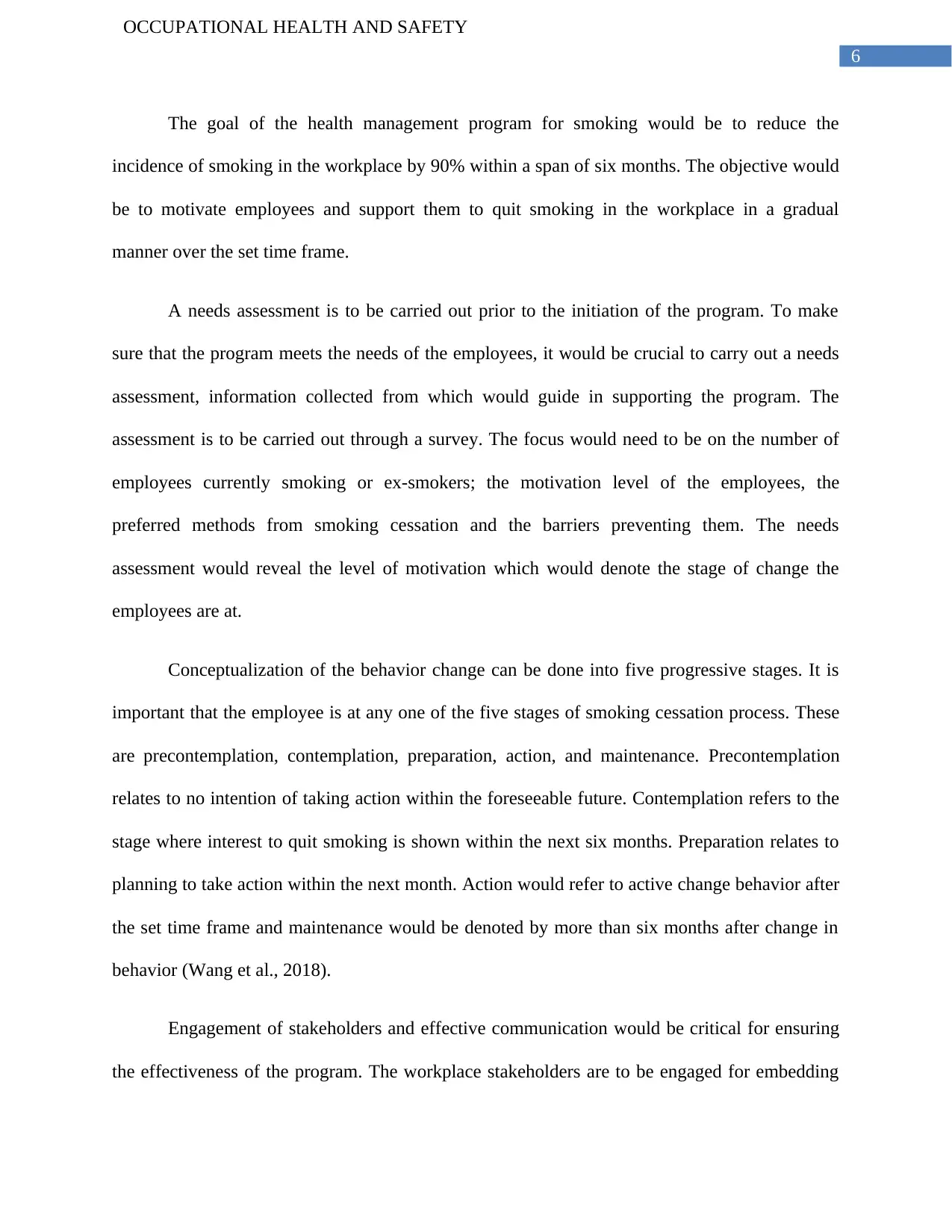
6
OCCUPATIONAL HEALTH AND SAFETY
The goal of the health management program for smoking would be to reduce the
incidence of smoking in the workplace by 90% within a span of six months. The objective would
be to motivate employees and support them to quit smoking in the workplace in a gradual
manner over the set time frame.
A needs assessment is to be carried out prior to the initiation of the program. To make
sure that the program meets the needs of the employees, it would be crucial to carry out a needs
assessment, information collected from which would guide in supporting the program. The
assessment is to be carried out through a survey. The focus would need to be on the number of
employees currently smoking or ex-smokers; the motivation level of the employees, the
preferred methods from smoking cessation and the barriers preventing them. The needs
assessment would reveal the level of motivation which would denote the stage of change the
employees are at.
Conceptualization of the behavior change can be done into five progressive stages. It is
important that the employee is at any one of the five stages of smoking cessation process. These
are precontemplation, contemplation, preparation, action, and maintenance. Precontemplation
relates to no intention of taking action within the foreseeable future. Contemplation refers to the
stage where interest to quit smoking is shown within the next six months. Preparation relates to
planning to take action within the next month. Action would refer to active change behavior after
the set time frame and maintenance would be denoted by more than six months after change in
behavior (Wang et al., 2018).
Engagement of stakeholders and effective communication would be critical for ensuring
the effectiveness of the program. The workplace stakeholders are to be engaged for embedding
OCCUPATIONAL HEALTH AND SAFETY
The goal of the health management program for smoking would be to reduce the
incidence of smoking in the workplace by 90% within a span of six months. The objective would
be to motivate employees and support them to quit smoking in the workplace in a gradual
manner over the set time frame.
A needs assessment is to be carried out prior to the initiation of the program. To make
sure that the program meets the needs of the employees, it would be crucial to carry out a needs
assessment, information collected from which would guide in supporting the program. The
assessment is to be carried out through a survey. The focus would need to be on the number of
employees currently smoking or ex-smokers; the motivation level of the employees, the
preferred methods from smoking cessation and the barriers preventing them. The needs
assessment would reveal the level of motivation which would denote the stage of change the
employees are at.
Conceptualization of the behavior change can be done into five progressive stages. It is
important that the employee is at any one of the five stages of smoking cessation process. These
are precontemplation, contemplation, preparation, action, and maintenance. Precontemplation
relates to no intention of taking action within the foreseeable future. Contemplation refers to the
stage where interest to quit smoking is shown within the next six months. Preparation relates to
planning to take action within the next month. Action would refer to active change behavior after
the set time frame and maintenance would be denoted by more than six months after change in
behavior (Wang et al., 2018).
Engagement of stakeholders and effective communication would be critical for ensuring
the effectiveness of the program. The workplace stakeholders are to be engaged for embedding
Paraphrase This Document
Need a fresh take? Get an instant paraphrase of this document with our AI Paraphraser
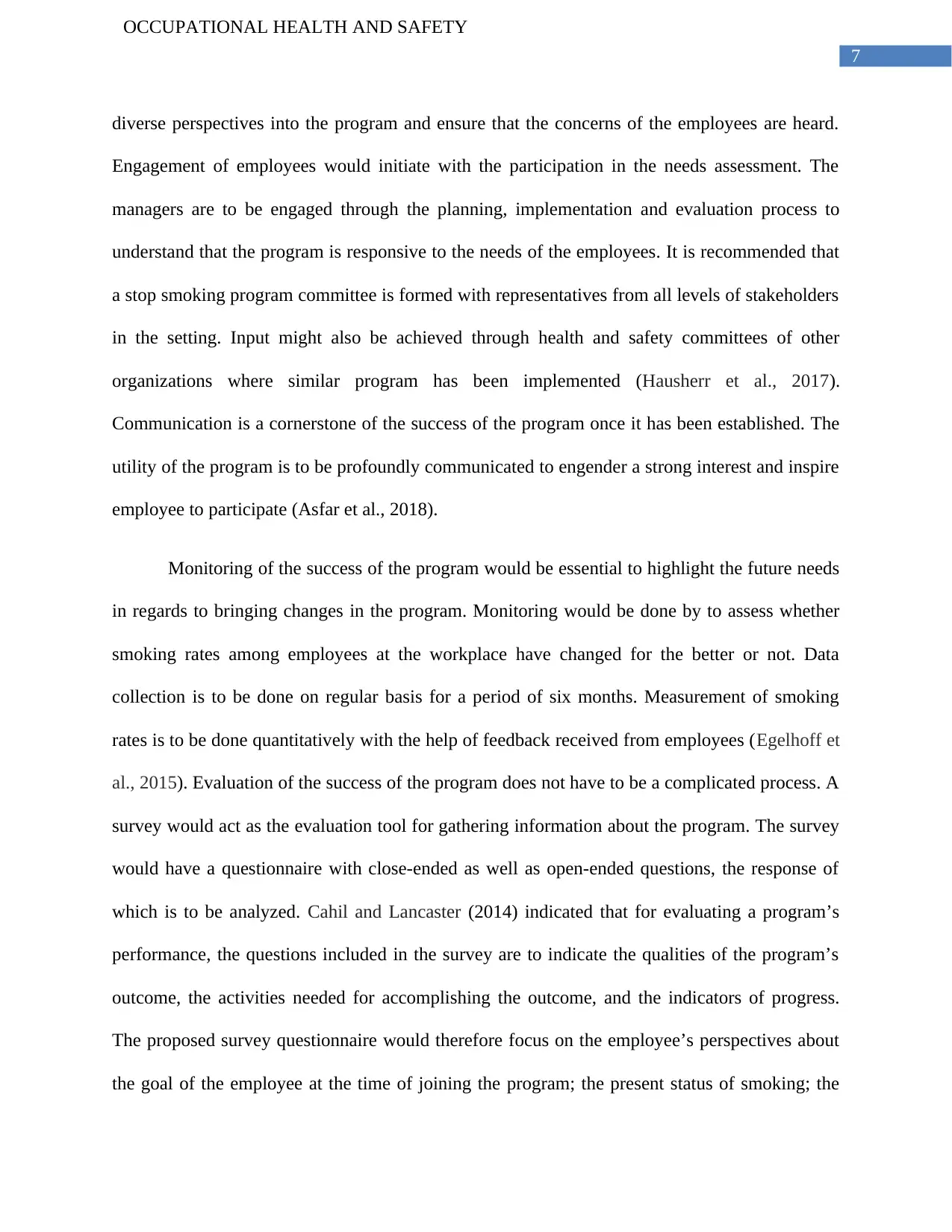
7
OCCUPATIONAL HEALTH AND SAFETY
diverse perspectives into the program and ensure that the concerns of the employees are heard.
Engagement of employees would initiate with the participation in the needs assessment. The
managers are to be engaged through the planning, implementation and evaluation process to
understand that the program is responsive to the needs of the employees. It is recommended that
a stop smoking program committee is formed with representatives from all levels of stakeholders
in the setting. Input might also be achieved through health and safety committees of other
organizations where similar program has been implemented (Hausherr et al., 2017).
Communication is a cornerstone of the success of the program once it has been established. The
utility of the program is to be profoundly communicated to engender a strong interest and inspire
employee to participate (Asfar et al., 2018).
Monitoring of the success of the program would be essential to highlight the future needs
in regards to bringing changes in the program. Monitoring would be done by to assess whether
smoking rates among employees at the workplace have changed for the better or not. Data
collection is to be done on regular basis for a period of six months. Measurement of smoking
rates is to be done quantitatively with the help of feedback received from employees (Egelhoff et
al., 2015). Evaluation of the success of the program does not have to be a complicated process. A
survey would act as the evaluation tool for gathering information about the program. The survey
would have a questionnaire with close-ended as well as open-ended questions, the response of
which is to be analyzed. Cahil and Lancaster (2014) indicated that for evaluating a program’s
performance, the questions included in the survey are to indicate the qualities of the program’s
outcome, the activities needed for accomplishing the outcome, and the indicators of progress.
The proposed survey questionnaire would therefore focus on the employee’s perspectives about
the goal of the employee at the time of joining the program; the present status of smoking; the
OCCUPATIONAL HEALTH AND SAFETY
diverse perspectives into the program and ensure that the concerns of the employees are heard.
Engagement of employees would initiate with the participation in the needs assessment. The
managers are to be engaged through the planning, implementation and evaluation process to
understand that the program is responsive to the needs of the employees. It is recommended that
a stop smoking program committee is formed with representatives from all levels of stakeholders
in the setting. Input might also be achieved through health and safety committees of other
organizations where similar program has been implemented (Hausherr et al., 2017).
Communication is a cornerstone of the success of the program once it has been established. The
utility of the program is to be profoundly communicated to engender a strong interest and inspire
employee to participate (Asfar et al., 2018).
Monitoring of the success of the program would be essential to highlight the future needs
in regards to bringing changes in the program. Monitoring would be done by to assess whether
smoking rates among employees at the workplace have changed for the better or not. Data
collection is to be done on regular basis for a period of six months. Measurement of smoking
rates is to be done quantitatively with the help of feedback received from employees (Egelhoff et
al., 2015). Evaluation of the success of the program does not have to be a complicated process. A
survey would act as the evaluation tool for gathering information about the program. The survey
would have a questionnaire with close-ended as well as open-ended questions, the response of
which is to be analyzed. Cahil and Lancaster (2014) indicated that for evaluating a program’s
performance, the questions included in the survey are to indicate the qualities of the program’s
outcome, the activities needed for accomplishing the outcome, and the indicators of progress.
The proposed survey questionnaire would therefore focus on the employee’s perspectives about
the goal of the employee at the time of joining the program; the present status of smoking; the
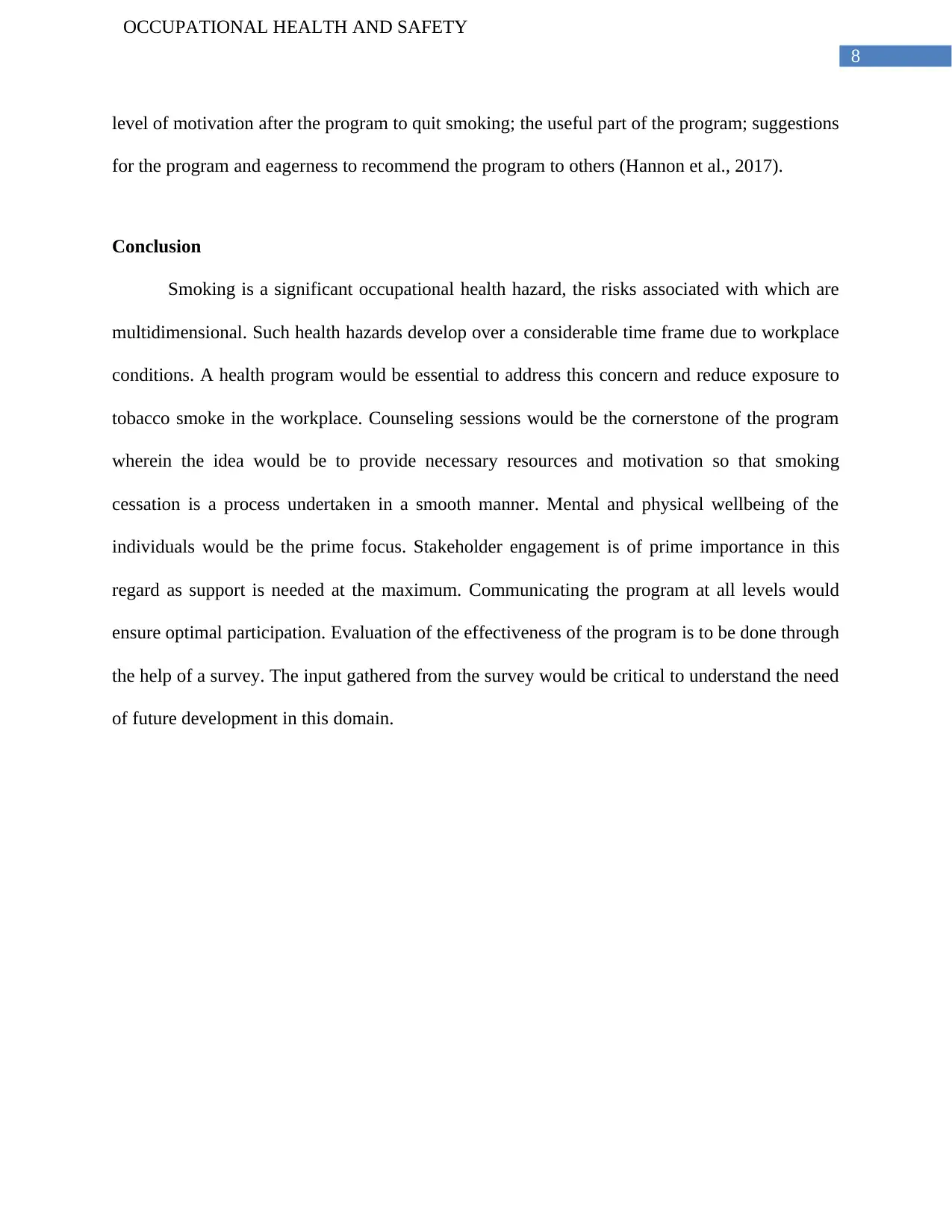
8
OCCUPATIONAL HEALTH AND SAFETY
level of motivation after the program to quit smoking; the useful part of the program; suggestions
for the program and eagerness to recommend the program to others (Hannon et al., 2017).
Conclusion
Smoking is a significant occupational health hazard, the risks associated with which are
multidimensional. Such health hazards develop over a considerable time frame due to workplace
conditions. A health program would be essential to address this concern and reduce exposure to
tobacco smoke in the workplace. Counseling sessions would be the cornerstone of the program
wherein the idea would be to provide necessary resources and motivation so that smoking
cessation is a process undertaken in a smooth manner. Mental and physical wellbeing of the
individuals would be the prime focus. Stakeholder engagement is of prime importance in this
regard as support is needed at the maximum. Communicating the program at all levels would
ensure optimal participation. Evaluation of the effectiveness of the program is to be done through
the help of a survey. The input gathered from the survey would be critical to understand the need
of future development in this domain.
OCCUPATIONAL HEALTH AND SAFETY
level of motivation after the program to quit smoking; the useful part of the program; suggestions
for the program and eagerness to recommend the program to others (Hannon et al., 2017).
Conclusion
Smoking is a significant occupational health hazard, the risks associated with which are
multidimensional. Such health hazards develop over a considerable time frame due to workplace
conditions. A health program would be essential to address this concern and reduce exposure to
tobacco smoke in the workplace. Counseling sessions would be the cornerstone of the program
wherein the idea would be to provide necessary resources and motivation so that smoking
cessation is a process undertaken in a smooth manner. Mental and physical wellbeing of the
individuals would be the prime focus. Stakeholder engagement is of prime importance in this
regard as support is needed at the maximum. Communicating the program at all levels would
ensure optimal participation. Evaluation of the effectiveness of the program is to be done through
the help of a survey. The input gathered from the survey would be critical to understand the need
of future development in this domain.
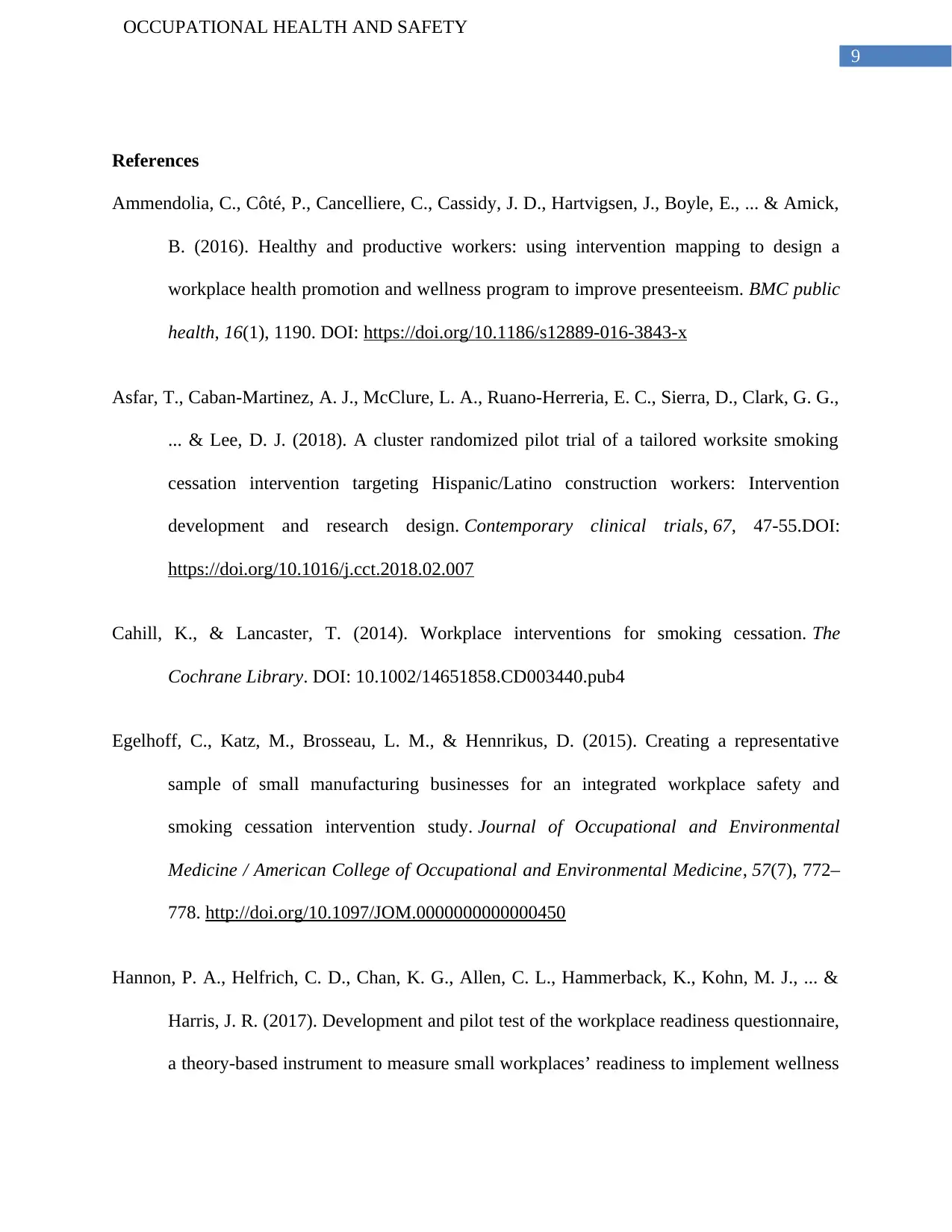
9
OCCUPATIONAL HEALTH AND SAFETY
References
Ammendolia, C., Côté, P., Cancelliere, C., Cassidy, J. D., Hartvigsen, J., Boyle, E., ... & Amick,
B. (2016). Healthy and productive workers: using intervention mapping to design a
workplace health promotion and wellness program to improve presenteeism. BMC public
health, 16(1), 1190. DOI: https://doi.org/10.1186/s12889-016-3843-x
Asfar, T., Caban-Martinez, A. J., McClure, L. A., Ruano-Herreria, E. C., Sierra, D., Clark, G. G.,
... & Lee, D. J. (2018). A cluster randomized pilot trial of a tailored worksite smoking
cessation intervention targeting Hispanic/Latino construction workers: Intervention
development and research design. Contemporary clinical trials, 67, 47-55.DOI:
https://doi.org/10.1016/j.cct.2018.02.007
Cahill, K., & Lancaster, T. (2014). Workplace interventions for smoking cessation. The
Cochrane Library. DOI: 10.1002/14651858.CD003440.pub4
Egelhoff, C., Katz, M., Brosseau, L. M., & Hennrikus, D. (2015). Creating a representative
sample of small manufacturing businesses for an integrated workplace safety and
smoking cessation intervention study. Journal of Occupational and Environmental
Medicine / American College of Occupational and Environmental Medicine, 57(7), 772–
778. http://doi.org/10.1097/JOM.0000000000000450
Hannon, P. A., Helfrich, C. D., Chan, K. G., Allen, C. L., Hammerback, K., Kohn, M. J., ... &
Harris, J. R. (2017). Development and pilot test of the workplace readiness questionnaire,
a theory-based instrument to measure small workplaces’ readiness to implement wellness
OCCUPATIONAL HEALTH AND SAFETY
References
Ammendolia, C., Côté, P., Cancelliere, C., Cassidy, J. D., Hartvigsen, J., Boyle, E., ... & Amick,
B. (2016). Healthy and productive workers: using intervention mapping to design a
workplace health promotion and wellness program to improve presenteeism. BMC public
health, 16(1), 1190. DOI: https://doi.org/10.1186/s12889-016-3843-x
Asfar, T., Caban-Martinez, A. J., McClure, L. A., Ruano-Herreria, E. C., Sierra, D., Clark, G. G.,
... & Lee, D. J. (2018). A cluster randomized pilot trial of a tailored worksite smoking
cessation intervention targeting Hispanic/Latino construction workers: Intervention
development and research design. Contemporary clinical trials, 67, 47-55.DOI:
https://doi.org/10.1016/j.cct.2018.02.007
Cahill, K., & Lancaster, T. (2014). Workplace interventions for smoking cessation. The
Cochrane Library. DOI: 10.1002/14651858.CD003440.pub4
Egelhoff, C., Katz, M., Brosseau, L. M., & Hennrikus, D. (2015). Creating a representative
sample of small manufacturing businesses for an integrated workplace safety and
smoking cessation intervention study. Journal of Occupational and Environmental
Medicine / American College of Occupational and Environmental Medicine, 57(7), 772–
778. http://doi.org/10.1097/JOM.0000000000000450
Hannon, P. A., Helfrich, C. D., Chan, K. G., Allen, C. L., Hammerback, K., Kohn, M. J., ... &
Harris, J. R. (2017). Development and pilot test of the workplace readiness questionnaire,
a theory-based instrument to measure small workplaces’ readiness to implement wellness
Secure Best Marks with AI Grader
Need help grading? Try our AI Grader for instant feedback on your assignments.
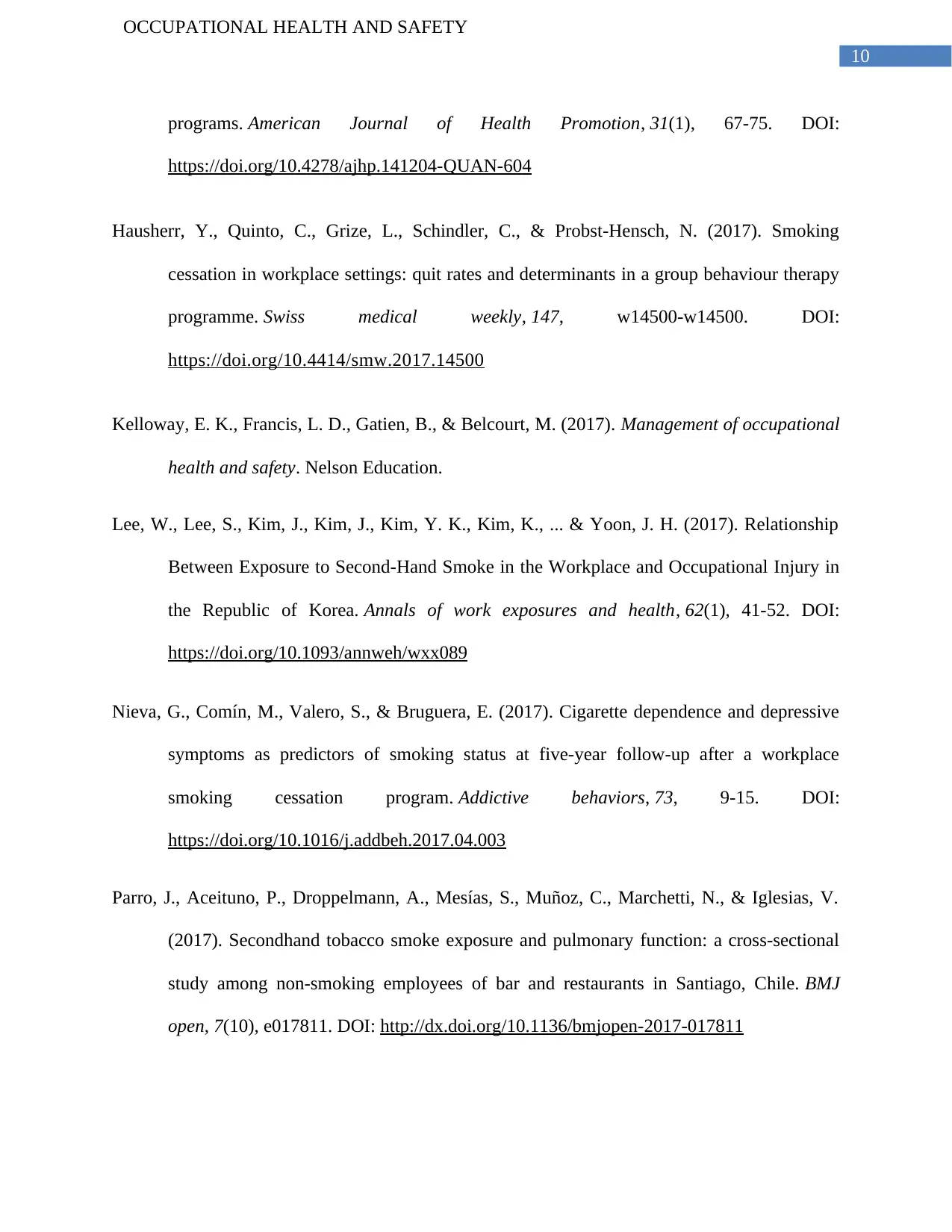
10
OCCUPATIONAL HEALTH AND SAFETY
programs. American Journal of Health Promotion, 31(1), 67-75. DOI:
https://doi.org/10.4278/ajhp.141204-QUAN-604
Hausherr, Y., Quinto, C., Grize, L., Schindler, C., & Probst-Hensch, N. (2017). Smoking
cessation in workplace settings: quit rates and determinants in a group behaviour therapy
programme. Swiss medical weekly, 147, w14500-w14500. DOI:
https://doi.org/10.4414/smw.2017.14500
Kelloway, E. K., Francis, L. D., Gatien, B., & Belcourt, M. (2017). Management of occupational
health and safety. Nelson Education.
Lee, W., Lee, S., Kim, J., Kim, J., Kim, Y. K., Kim, K., ... & Yoon, J. H. (2017). Relationship
Between Exposure to Second-Hand Smoke in the Workplace and Occupational Injury in
the Republic of Korea. Annals of work exposures and health, 62(1), 41-52. DOI:
https://doi.org/10.1093/annweh/wxx089
Nieva, G., Comín, M., Valero, S., & Bruguera, E. (2017). Cigarette dependence and depressive
symptoms as predictors of smoking status at five-year follow-up after a workplace
smoking cessation program. Addictive behaviors, 73, 9-15. DOI:
https://doi.org/10.1016/j.addbeh.2017.04.003
Parro, J., Aceituno, P., Droppelmann, A., Mesías, S., Muñoz, C., Marchetti, N., & Iglesias, V.
(2017). Secondhand tobacco smoke exposure and pulmonary function: a cross-sectional
study among non-smoking employees of bar and restaurants in Santiago, Chile. BMJ
open, 7(10), e017811. DOI: http://dx.doi.org/10.1136/bmjopen-2017-017811
OCCUPATIONAL HEALTH AND SAFETY
programs. American Journal of Health Promotion, 31(1), 67-75. DOI:
https://doi.org/10.4278/ajhp.141204-QUAN-604
Hausherr, Y., Quinto, C., Grize, L., Schindler, C., & Probst-Hensch, N. (2017). Smoking
cessation in workplace settings: quit rates and determinants in a group behaviour therapy
programme. Swiss medical weekly, 147, w14500-w14500. DOI:
https://doi.org/10.4414/smw.2017.14500
Kelloway, E. K., Francis, L. D., Gatien, B., & Belcourt, M. (2017). Management of occupational
health and safety. Nelson Education.
Lee, W., Lee, S., Kim, J., Kim, J., Kim, Y. K., Kim, K., ... & Yoon, J. H. (2017). Relationship
Between Exposure to Second-Hand Smoke in the Workplace and Occupational Injury in
the Republic of Korea. Annals of work exposures and health, 62(1), 41-52. DOI:
https://doi.org/10.1093/annweh/wxx089
Nieva, G., Comín, M., Valero, S., & Bruguera, E. (2017). Cigarette dependence and depressive
symptoms as predictors of smoking status at five-year follow-up after a workplace
smoking cessation program. Addictive behaviors, 73, 9-15. DOI:
https://doi.org/10.1016/j.addbeh.2017.04.003
Parro, J., Aceituno, P., Droppelmann, A., Mesías, S., Muñoz, C., Marchetti, N., & Iglesias, V.
(2017). Secondhand tobacco smoke exposure and pulmonary function: a cross-sectional
study among non-smoking employees of bar and restaurants in Santiago, Chile. BMJ
open, 7(10), e017811. DOI: http://dx.doi.org/10.1136/bmjopen-2017-017811
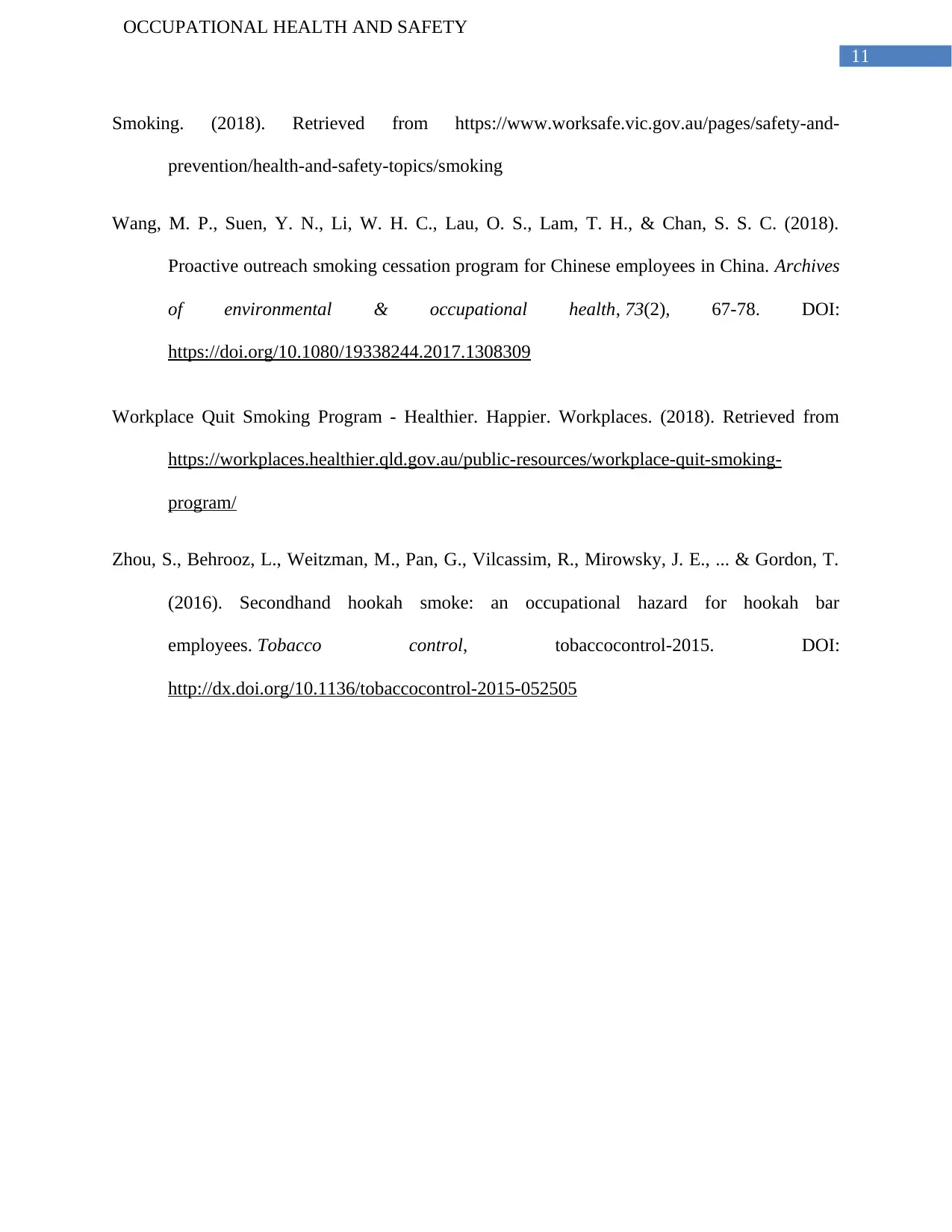
11
OCCUPATIONAL HEALTH AND SAFETY
Smoking. (2018). Retrieved from https://www.worksafe.vic.gov.au/pages/safety-and-
prevention/health-and-safety-topics/smoking
Wang, M. P., Suen, Y. N., Li, W. H. C., Lau, O. S., Lam, T. H., & Chan, S. S. C. (2018).
Proactive outreach smoking cessation program for Chinese employees in China. Archives
of environmental & occupational health, 73(2), 67-78. DOI:
https://doi.org/10.1080/19338244.2017.1308309
Workplace Quit Smoking Program - Healthier. Happier. Workplaces. (2018). Retrieved from
https://workplaces.healthier.qld.gov.au/public-resources/workplace-quit-smoking-
program/
Zhou, S., Behrooz, L., Weitzman, M., Pan, G., Vilcassim, R., Mirowsky, J. E., ... & Gordon, T.
(2016). Secondhand hookah smoke: an occupational hazard for hookah bar
employees. Tobacco control, tobaccocontrol-2015. DOI:
http://dx.doi.org/10.1136/tobaccocontrol-2015-052505
OCCUPATIONAL HEALTH AND SAFETY
Smoking. (2018). Retrieved from https://www.worksafe.vic.gov.au/pages/safety-and-
prevention/health-and-safety-topics/smoking
Wang, M. P., Suen, Y. N., Li, W. H. C., Lau, O. S., Lam, T. H., & Chan, S. S. C. (2018).
Proactive outreach smoking cessation program for Chinese employees in China. Archives
of environmental & occupational health, 73(2), 67-78. DOI:
https://doi.org/10.1080/19338244.2017.1308309
Workplace Quit Smoking Program - Healthier. Happier. Workplaces. (2018). Retrieved from
https://workplaces.healthier.qld.gov.au/public-resources/workplace-quit-smoking-
program/
Zhou, S., Behrooz, L., Weitzman, M., Pan, G., Vilcassim, R., Mirowsky, J. E., ... & Gordon, T.
(2016). Secondhand hookah smoke: an occupational hazard for hookah bar
employees. Tobacco control, tobaccocontrol-2015. DOI:
http://dx.doi.org/10.1136/tobaccocontrol-2015-052505
1 out of 12
Related Documents
Your All-in-One AI-Powered Toolkit for Academic Success.
+13062052269
info@desklib.com
Available 24*7 on WhatsApp / Email
![[object Object]](/_next/static/media/star-bottom.7253800d.svg)
Unlock your academic potential
© 2024 | Zucol Services PVT LTD | All rights reserved.





